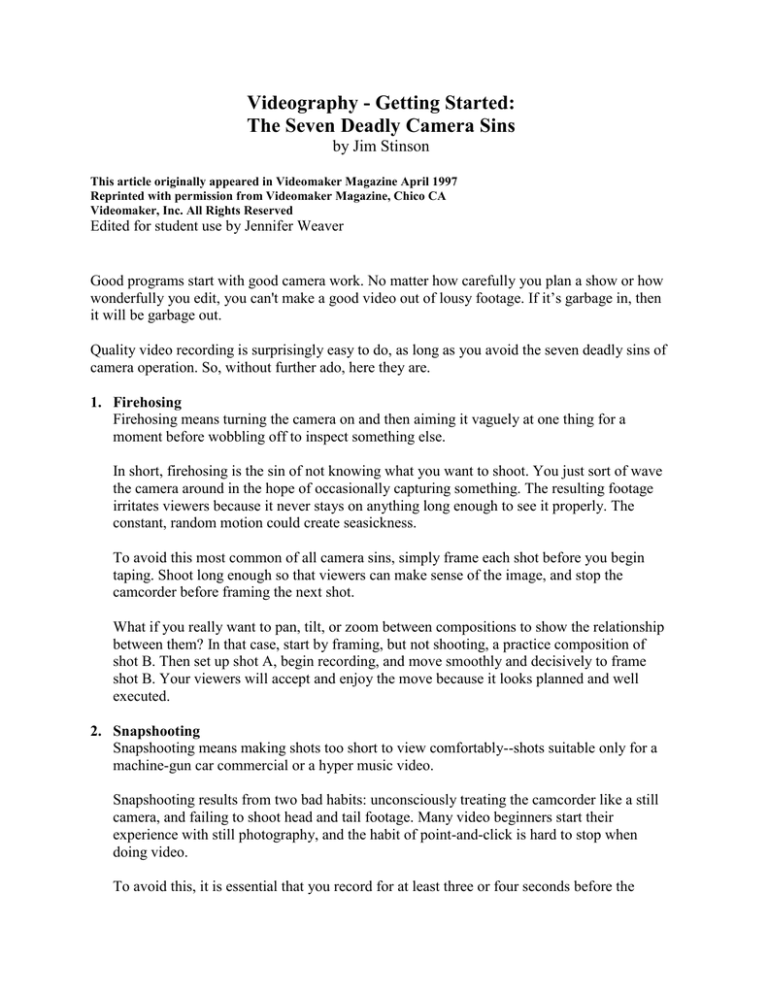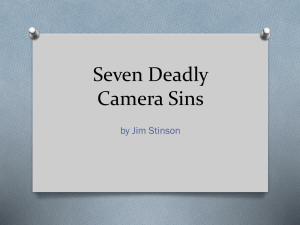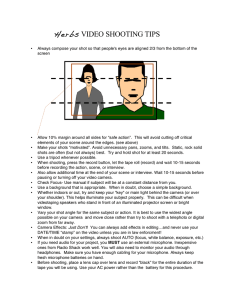
Videography - Getting Started:
The Seven Deadly Camera Sins
by Jim Stinson
This article originally appeared in Videomaker Magazine April 1997
Reprinted with permission from Videomaker Magazine, Chico CA
Videomaker, Inc. All Rights Reserved
Edited for student use by Jennifer Weaver
Good programs start with good camera work. No matter how carefully you plan a show or how
wonderfully you edit, you can't make a good video out of lousy footage. If it’s garbage in, then
it will be garbage out.
Quality video recording is surprisingly easy to do, as long as you avoid the seven deadly sins of
camera operation. So, without further ado, here they are.
1. Firehosing
Firehosing means turning the camera on and then aiming it vaguely at one thing for a
moment before wobbling off to inspect something else.
In short, firehosing is the sin of not knowing what you want to shoot. You just sort of wave
the camera around in the hope of occasionally capturing something. The resulting footage
irritates viewers because it never stays on anything long enough to see it properly. The
constant, random motion could create seasickness.
To avoid this most common of all camera sins, simply frame each shot before you begin
taping. Shoot long enough so that viewers can make sense of the image, and stop the
camcorder before framing the next shot.
What if you really want to pan, tilt, or zoom between compositions to show the relationship
between them? In that case, start by framing, but not shooting, a practice composition of
shot B. Then set up shot A, begin recording, and move smoothly and decisively to frame
shot B. Your viewers will accept and enjoy the move because it looks planned and well
executed.
2. Snapshooting
Snapshooting means making shots too short to view comfortably--shots suitable only for a
machine-gun car commercial or a hyper music video.
Snapshooting results from two bad habits: unconsciously treating the camcorder like a still
camera, and failing to shoot head and tail footage. Many video beginners start their
experience with still photography, and the habit of point-and-click is hard to stop when
doing video.
To avoid this, it is essential that you record for at least three or four seconds before the
action you want and another three or four after it apparently ends. This is important to do in
order to make sure that you capture everything you need to make your shot, and nothing
gets cut off.
3. Headhunting
Headhunting is the practice of framing subjects so that their eyes are in the exact center of
the image: half- way down from the top and half-way in from the sides. It's called
headhunting because the resulting composition looks like the picture in a gun sight. (Ouch!)
Centering people is natural because that's the way we look at them in real life, eyeball to
eyeball (unless we're selling them TVs off the back of a truck). But our human vision does
not have a border around it like the frame around a video image. Like it or not, that frame
turns visual information into a picture; and a composition that centers the eyes looks, well,
dumb.
As a rule of thumb, headhunting can be avoided if you keep the subject's eyes on or above
an imaginary horizontal line drawn one-third of the way down from the top of the frame.
4. Backlighting
Backlighting is the sin of posing the subject (usually one or more people) in front of the sky
or a ski slope or a body of water so that the important foreground is much darker than the
unimportant background. When this happens, they become inky silhouettes.
Before you can take steps to prevent backlighting, you have to notice that it's happening; so,
for goodness sake, study the image in your viewfinder. If it does not clearly show detail in
people's faces or other important foreground elements, you've got yourself a bad case of
backlighting.
The easiest way to fix backlighting is to move camcorder and subjects until the foreground
of your shot is at least as bright as the background. To eliminate sky, start by shooting from
a higher camera position. At the beach, simply turn away from the glare off the water.
5. Motorzooming
Motorzooming is the sin of, well, zooming. No matter how nifty your wide-range, multispeed, auto- zoom feature may be, the fact is that on-screen zooms are a dull waste of
viewer time and professionals don't use them except in two circumstances:
• During real-time coverage like news and sports, when the need to keep an image on the
screen mandates zooming between compositions.
• Situations that require a progressive revelation of the image: The dark figure at the
door pulls a sinister tool from her pocket. We zoom in to reveal that it is... her door key!
If you have a zoom lens, zooming is inescapable because it's the only way to change image
size without physically moving forward or back. But plan your shots to eliminate these
zooms. Zoom between shots.
6. Upstanding
Upstanding is the somewhat subtler sin of shooting everything from standing eye level, even
though much of the world is better viewed from higher or lower angles.
So, as the man says, get down! Shoot children, pets, flowers, and other lowly critters from
their own levels. All camcorders allow you to put the unit right on the ground and view the
image by tilting the viewfinder upward.
Full-size VHS camcorders let you tilt the finder down as well. You can raise the camcorder
high in the air for dramatic establishing shots and footage grabbed over the heads of crowds.
7. Jogging
Jogging is the sin of walking while shooting. Joggers give no thought to the fact that the
image is bouncing around like a milk can in the bed of a Model T.
Moving shots are dramatic and exciting, so go for them! But to ensure that most of the
movement is forward rather than bouncing up and down, observe these simple rules for
hand-held shooting:
• Zoom out as far as you can go to minimize shake. The zoomed-in position magnifies
the jitters along with everything else.
• Don't touch the viewfinder with your forehead
• Walk with both knees and elbows bent to create natural shock absorbers.
• Move more slowly than normal, so that the scene has a chance to register with viewers.
• Pretend the camcorder you're carrying is a very full, very hot cup of coffee--and you'd
better not spill a drop!
Deadlier Than the Average Sin
Are all seven camera sins equally deadly? Not really.
• Avoid the worse sins of firehosing and snapshooting and you'll immediately make
really bad film at least watchable.
• Eliminate headhunting and backlighting and you graduate from newbie status.
• Banish motorzooming, upstanding, and jogging and you'll find that without even
noticing, you've become quite a skilled videographer.
Good shooting!
Source: Professional Education Center, University of Alaska Southeast, Juneau Alaska
http://pec.jun.alaska.edu:16080/edtechpec/ed634/videomaker/seven_sins.html



